Set Language | Maths - Application on Cardinality of Sets | 9th Maths : UNIT 1 : Set Language
Chapter: 9th Maths : UNIT 1 : Set Language
Application on Cardinality of Sets
Application on Cardinality
of Sets:
We
have learnt about the union, intersection, complement and difference of sets.
Now
we will go through some practical problems on sets related to everyday life.
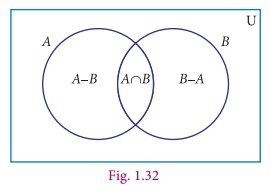
Results :
If
A and B are two finite sets, then
(i) n(AŌł¬B) = n(A)+n(B)ŌĆō
n(AŌł®B)
(ii) n(AŌĆōB)
= n(A) ŌĆō n(AŌł®B)
(iii)
n(BŌĆōA) = n(B)ŌĆō n(AŌł®B)
(iv)
n(AŌĆ▓) = n(U) ŌĆō n(A)
Note
From the above results we may get,
ŌĆó n(AŌł®B) = n(A)+n(B)
ŌĆō n(AŌł¬B)
ŌĆó n(U) = n(A)+n(AŌĆ▓)
ŌĆó If A and B are disjoint sets then, n(AŌł¬B) = n(A)+n(B).
Example 1.27
From the Venn diagram, verify that n(AŌł¬B) = n(A)+n(B) ŌĆō n(AŌł®B)
Solution From the venn diagram,
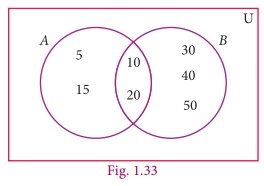
A
= {5, 10, 15, 20}
B
= {10, 20, 30, 40, 50,}
Then
AŌł¬B = {5, 10, 15, 20, 30, 40, 50}
AŌł®B
= {10, 20}
n(A) = 4, n(B) =
5, n(AŌł¬B) = 7, n(AŌł®B) = 2
n(AŌł¬B) = 7 ŌĆ”ŌĆ”..(1)
n(A)+n(B)ŌĆōn(AŌł®B)
= 4+5ŌĆō2
=7 ŌĆ”ŌĆ”..(2)
From
(1) and (2), n(AŌł¬B) = n(A)+n(B)ŌĆōn(AŌł®B).
Example 1.28
If n(A) = 36, n(B) = 10, n(AŌł¬B)=40, and n(AŌĆ▓)=27 find n(U) and n(AŌł®B).
Solution n(A) = 36, n(B) =10,
n(AŌł¬B)=40, n(AŌĆ▓)=27
(i) n(U)
= n(A)+n(AŌĆ▓) = 36+27 = 63
(ii) n(AŌł®B) = n(A)+n(B)ŌĆōn(AŌł¬B) = 36+10-40 = 46-40 = 6
Activity-4
Fill in the blanks with appropriate cardinal numbers.


Example 1.29
Let A={b, d, e, g, h} and
B = {a, e, c, h}. Verify that n(AŌĆōB)
= n(A)ŌĆōn(AŌł®B).
Solution
A=
{b, d, e, g, h}, B = {a, e,
c, h}
A
ŌĆō B = {b, d, g}
n(AŌĆōB) = 3 ... (1)
A
Ōł® B = {e, h}
n(A
Ōł® B) = 2 , n(A) = 5
n(A) ŌĆō n(AŌł®B) = 5-2
=
3
... (2)
Form
(1) and (2) we get n(AŌĆōB) = n(A)ŌĆōn(AŌł®B).
Example 1.30
In a school, all students play either Hockey or Cricket or both.
300 play Hockey, 250 play Cricket and 110 play both games. Find
(i) the number of students who play only Hockey.
(ii) the number of students who play only Cricket.
(iii) the total number of students in the School.
Solution:
Let
H be the set of all students who play Hockey and C be the set of all
students who play Cricket.
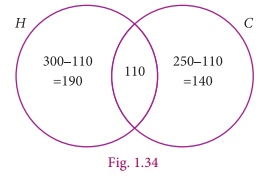
Then
n(H) = 300, n(C) = 250 and n(H Ōł®
C) = 110
Using Venn
diagram,
From
the Venn diagram,
(i)
The number of students who play only Hockey = 190
(ii)
The number of students who play only Cricket = 140
(iii)
The total number of students in the school = 190+110+140 =440
Aliter
(i)
The number of students who play only Hockey
n(HŌĆōC ) = n(H)
ŌĆō n(HŌł®C)
=300 ŌĆō110 = 190
(ii)
The number of students who play only Cricket
n(CŌĆōH ) = n(C)
ŌĆō n(HŌł®C)
= 250 ŌĆō 110 = 140
(iii)
The total number of students in the school
n(HUC) = n(H)
+ n(C) ŌĆō n(HŌł®C)
=
300+250 ŌĆō 110 = 440
Example 1.31
In a party of 60 people, 35 had Vanilla ice cream, 30 had Chocolate
ice cream. All the people had at least one ice cream. Then how many of them had,
(i) both Vanilla and Chocolate ice cream.
(ii) only Vanilla ice cream.
(iii) only Chocolate ice cream.
Solution :
Let V
be the set of people who had Vanilla ice cream and C be the set of people
who had Chocolate ice cream.
Then n(V)
= 35, n(C) = 30, n(VŌł¬C) = 60,
Let
x be the number of people who had both ice creams.
From
the Venn diagram
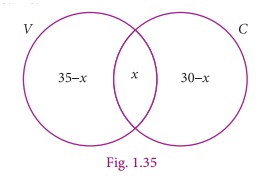
35
ŌĆō x + x +30 ŌĆō x = 60
65
ŌĆō x = 60
x= 5
Hence
5 people had both ice creams.
(i)
Number of people who had only Vanilla ice cream = 35 ŌĆō x
=35ŌĆō5=30
(ii)
Number of people who had only Chocolate ice cream = 30 ŌĆō x
=30ŌĆō5=25
We
have learnt to solve problems involving two sets using the formula n (A
Ōł¬ B ) =
n(A) +
n(B ) ŌłÆn(A Ōł®
B). Suppose we have three sets,
we can apply this formula to get a similar formula for three sets.
For any three finite sets A, B and C
n (A Ōł¬ B Ōł¬C) = n (A) + n (B) + n (C) ŌłÆn (A Ōł® B ) ŌłÆ n (B Ōł®C) ŌłÆ n (A Ōł®C ) + n (A Ōł® B Ōł®C)
Note
Let us consider the following results which will be useful in solving
problems using Venn diagram. Let three sets A, B and C represent
the students. From the Venn diagram,
Number of students in only set A = a, only set B = b, only set C = c .
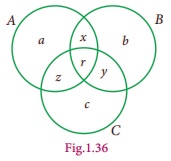
ŌĆó Total number of students in only one set = (a
+b +c)
ŌĆó Total number of students in only two sets = (x + y + z)
ŌĆó Number of students exactly in three sets = r
ŌĆó Total number of students in atleast two sets (two or more sets) =
x + y +z + r
ŌĆó Total number of students in 3 sets = (a + b + c + x + y + z + r)
Example 1.32
In
a college, 240 students play cricket, 180 students play football, 164 students play
hockey, 42 play both cricket and football, 38 play both football and hockey, 40
play both cricket and hockey and 16 play all the three games. If each student participate
in atleast one game, then find (i) the number of students in the college (ii) the
number of students who play only one game.
Solution
Let
C, F and H represent sets of students who play Cricket, Football
and Hockey respectively.
Then
, n (C ) = 240, n (F) =
180, n (H ) = 164, n (C Ōł®
F) = 42,
n
(F Ōł®
H ) =
38, n (C Ōł®
H) =
40, n (C Ōł®
F Ōł®
H) =
16.
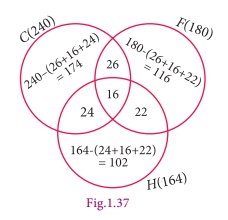
Let
us represent the given data in a Venn diagram.
(i)
The number of students in the college
=174+26+116+22+102+24+16
= 480
(ii)
The number of students who play only one game
=
174+116+102 = 392
Example 1.33
In
a residential area with 600 families 3/5 owned scooter, 1/3 owned car, 1/4 owned
bicycle, 120 families owned scooter and car, 86 owned car and bicylce while 90 families
owned scooter and bicylce. If 2/15 of families owned all the three types of vehicles,
then find (i) the number of families owned atleast two types of vehicle. (ii) the
number of families owned no vehicle.
Solution Let
S, C and B represent sets of families who owned Scooter, Car
and Bicycle respectively.
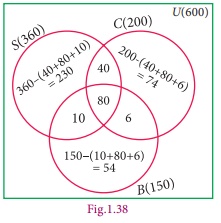
Given,
n( U) = 600
n(S) = 3/5 ├Ś 600 = 360
n (C ) = 1/3 ├Ś 600 = 200
n (B) = 1/4 ├Ś 600 = 150
n
(S Ōł® C Ōł® B) = 2/15 ├Ś 600 = 80
From
Venn diagram,
(i)
The number of families owned atleast two types of vehicles = 40+6+10+80 = 136
(ii)
The number of families owned no vehicle
= 600 ŌĆō (owned atleast one vehicle)
= 600ŌłÆ(230+40+74 +6+54 +10+80)
= 600 ŌłÆ 494 = 106
Example 1.34
In a group
of 100 students, 85 students speak Tamil, 40 students speak English, 20 students
speak French, 32 speak Tamil and English, 13 speak English and French and 10 speak
Tamil and French. If each student knows atleast any one of these languages, then
find the number of students who speak all these three languages.
Solution Let
A, B and C represent sets of students who speak Tamil, English
and French respectively.
Given, n (A Ōł¬
B Ōł¬C) = 100, n (A) =
85, n(B) =
40, n(C) =
20,
n (AŌł® B) =
32, n (BŌł®
C ) =
13, n (AŌł®
C ) =
10 .
We
know that,
n
(A Ōł¬ B Ōł¬C) = n (A) +
n (B) +
n (C) ŌłÆ
n (A Ōł®
B) ŌłÆ
n (B Ōł®C
) ŌĆō n
(A Ōł®C) +
n (A Ōł®
B Ōł®C)
100=
85 +
40 +
20 ŌłÆ
32 ŌłÆ13
ŌłÆ
10 +
n (A Ōł® B Ōł®C)
Then,
n (A Ōł® B Ōł®C) = 100 ŌłÆ 90 = 10
Therefore,
10 students speak all the three languages.
Example 1.35
A
survey was conducted among 200 magazine subscribers of three different magazines
A, B and C. It was found that 75 members do not subscribe magazine
A, 100 members do not subscribe magazine B, 50 members do not subscribe
magazine C and 125 subscribe atleast two of the three magazines. Find
(i)
Number of members who subscribe exactly two magazines.
(ii)
Number of members who subscribe only one magazine.
Solution
Total
number of subscribers = 200

From
the Venn diagram,
Number
of members who subscribe only one magazine = a +b +c
Number
of members who subscribe exactly two magazines = x +
y + z and 125 members subscribe atleast two magazines.
That
is, x + y + z +
r = 125 ... (1)
Now,
n (A Ōł¬
B Ōł¬C) = 200 , n(A) = 125, n(B)
= 100, n(C) = 150, n(A Ōł®
B) = x + r
n(B Ōł®
C) = y + r, n(A
Ōł®
C) = z + r, n(A Ōł® B Ōł®
C) = r
We
know that,
n(A Ōł¬ B Ōł¬ C) = n(A)+ n(B)+ n(C)ŌĆō
n(A Ōł® B) ŌĆō n(B Ōł® C)ŌĆō n(A Ōł®
C)+ n(A Ōł®
B Ōł®
C)
200
= 125+100+150ŌĆōxŌĆōrŌĆōyŌĆōrŌĆōzŌĆōr+r
=
375ŌĆō(x+y+z+r)ŌĆōr
=
375ŌĆō125ŌĆōr [x + y + z + r =
125]
200
= 250ŌĆōr ŌćÆ r = 50
From (1)
x + y + z +
50 = 125
We get, x + y +
z = 75
Therefore,
number of members who subscribe exactly two magazines = 75.
From
Venn diagram,
(a
+
b + c ) + (x +
y + z + r) = 200 ...
(2)
substitute
(1) in (2),
a +
b +
c +
125 = 200
a +
b +
c = 75
Therefore,
number of members who subscribe only one magazine = 75.
Related Topics